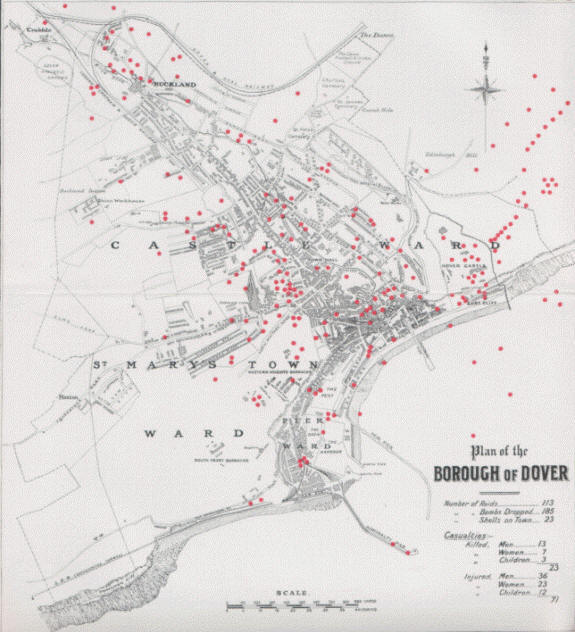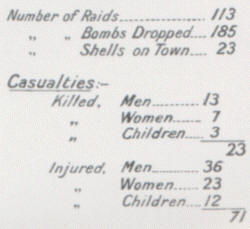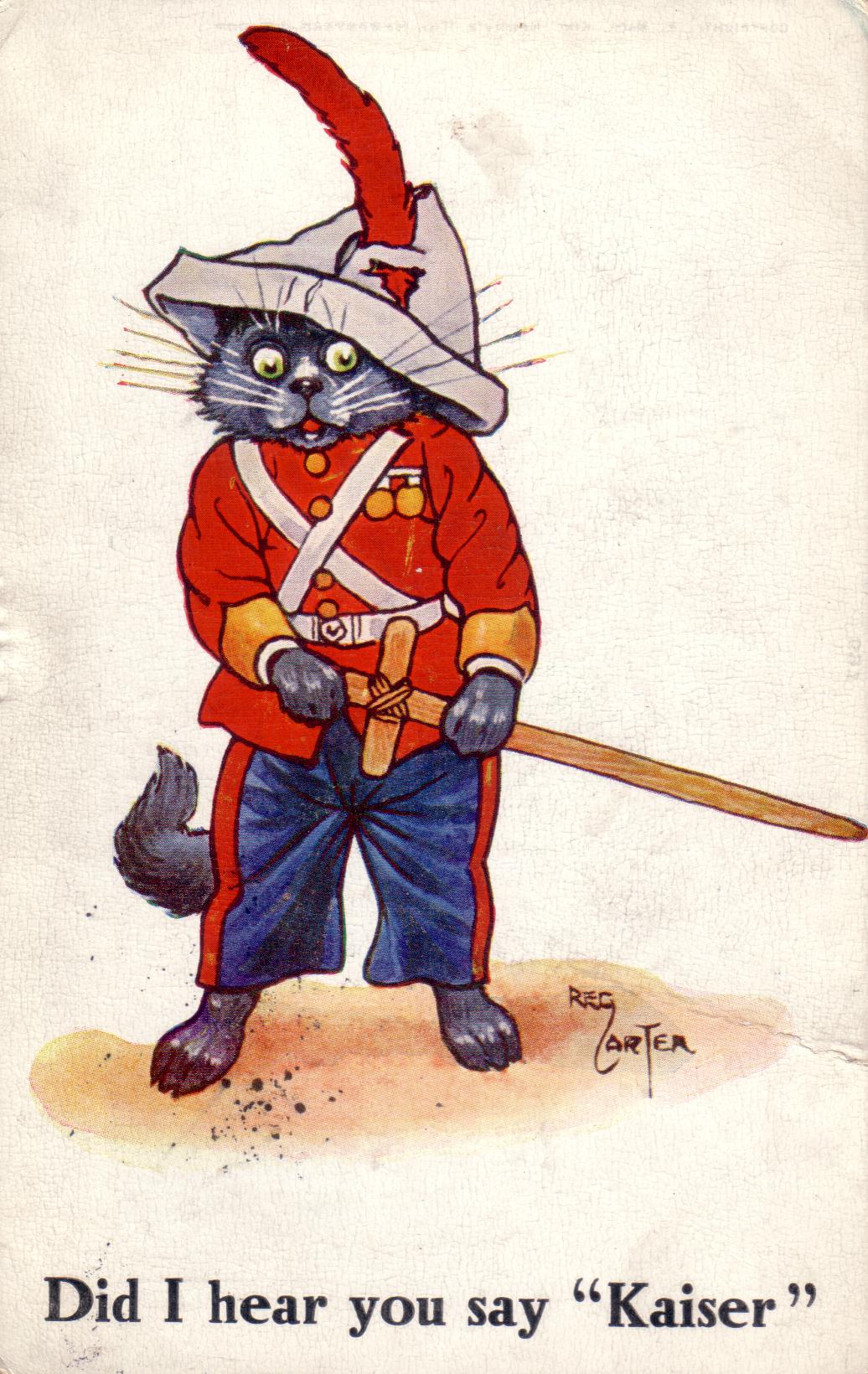| Index |
Dover and the War - 1914-18
|
| |
The quotations on this page have come from the book of the
same name, written shortly after the war by O. G. Bavington Jones, printed
and published by the Dover Express, Snargate Street, Dover. |
| |
|
| |
 |
|
This map (above), taken from
Dover and the Great War, by J.B. Frith, shows where the bombs and
shells landed in and around Dover in the war. The actual map is of a
much earlier date, as can be seen by the fact that the Admiralty Harbour
has not yet been built.
The detail (right) shows the number
of air raids, etc., and the casualties resulting from them. |
 |
|
| |
1914
|
First Bomb
"There were prizes offered in Germany for the first German airman
to bomb Dover, and a well-known German flyer ... who had been in England
earlier in the year, named Rumper, won it. Shortly before 11
o'clock, on December 24th, an aeroplane of the shape of the German Taube
machines, was seen flying down the valley, and it dropped a bomb which
burst in the kitchen garden of Mr. T. A. Terson, at the end of Leyburne
Road. The bomb was probably meant for the Castle, and where it
burst it did no damage beyond breaking adjoining windows and throwing a
gardener, named Banks, who was working at St. James's Rectory, out of a
tree to the ground, slightly injuring him. Only the one bomb was
dropped, and the aeroplane at once flew back in the direction of the
Flanders Coast."
|

Post Card from WW1 |
| |
1914-15
|
| |
Licensing Restrictions
"In Dover, the licensing restrictions imposed were as severe as
any in the country. The public-houses were closed at 9 o'clock
very soon after the war started, and at one time were not opened till 5
o'clock to Service men. When the general restrictions on the
public came into force, the houses were opened from 12 noon to 2.30p.m.,
and from 6p.m. to 8p.m."
Before the war, many public houses in the town had been permitted to
open from 5a.m. and close a 10p.m.
|
1915
|
Air Raids
"On May 3rd, at 10.55 a.m., an aeroplane coming from France, and
thought to be hostile, was fired at for nearly ten minutes by the Dover
guns. The Dover syren, which had been installed at the Electricity
Works, was blown on this occasion for the first time as an air raid
warning. It was the first time anti-aircraft guns had been in
action in Dover, and the occasion created intense excitement in the
town. People rushed on to the Sea Front, and expressed the
greatest disappointment at the shots failing to hit the target, few then
realising in England the difficulties of anti-aircraft gunnery. It
was fortunate, however, that it was not hit, as it happened to be one of
our own machines. However, a fortnight later, in May, Dover had a
real raid.
|
1915-17
|
Entertainment
"The places of amusement were, in October, all closed at 10p.m.,
and in November notice was given that Dover became an area subject to
the Liquor Control Board, who, on January 10th, 1916, brought into force
an order by which public-houses were only opened between the hours of 12
noon and 2.30 p.m., and 6 and 8p.m."
|
|
Despite the early closure of public houses and theatres, there was a great
deal of entertainment available for the troops and the public during the
war. Smoking Concerts were held for the troops as shown by this
report in the Dover Express of December 14th 1917 (page 5) :
Volunteer’s Smoking Concert
There was a crowded attendance at the School of Instruction of ‘C’
Company, 1st Kent Volunteer Regiment, on Wednesday evening, when a
smoking concert in connection with the recruiting rally was held.
There were regular concerts in aid of various charitable funds, in the
Town Hall and other venues around the town. One of the popular
performers at these events was Lance Corporal William John Thomas (Billy) Beer of the
Royal Engineers. |

It could be him that Mabel Rudkin was referring to in her book “Inside Dover
1914-1918”
when she wrote:
“ Soldiers continue to figure at the recurring
Temperance Teas, Some assisting at the concerts. A dapper, swaggering
corporal, sporting a smart cane, had a fine tenor voice, and was much in
demand as a singer. He fluttered many feminine hearts with his melodies
entreaties to ''Keep the Home Fires Burning," and the rendering of other
popular lyrics. Then he, too, began to collect useful names and addresses,
and adopted the plan of dropping in to see us, usually about supper-time.”
Billy is reported as having performed in over 600 concerts in Dover
during the war - that averages out at about three a week for the duration
- and there were many more that he did not take part in.
Other popular acts at these events included "Mr. T. Mann, a well known Dover entertainer",
"Mrs. Mitchens and party", "Mr. W.J. Moor and his concert party"
and "Miss Winnie Winneford, soprano vocalist"
Locations included the Town Hall, the King's Hall, the Duke of York's
School, the Missions to Seamen's Institute, the Tipperary Tea Rooms (Bench
Street), the Carriage Builders Institute (Cherry Tree Avenue), The Royal
Engineers' Drill Hall (Liverpool Street) and the Ordnance Department.
|
1915-18
|
Railways
"At the end of 1915, with the blocking of the South Eastern line
at the Warren, due to the landslip, Dover had to rely wholly on the
London, Chatham and Dover Railway. The London, Chatham and Dover
Railway system is by no means an ideal one, with its heavy gradients,
and the hospital trains with their great weights were difficult to haul
up such gradients. Additional to this hospital and war material
traffic, in the summer of 1917 there began to flow through Dover the
leave men from the Armies in France. Following this came drafts
for France, which up till th.en had never passed through Dover.
With the great German offensive of the Spring of 1918, a whole Army
passed through Dover, followed by a tremendous number of American
troops. The march of these long columns of American infantry
through the Dover streets was a sight never to be forgotten.
During this time the railway line between Dover and London was never at
rest. Every few minutes there came roaring through either a troop
train, a special, or a hospital train, and it was a wonderful thing how
the railway officials at Dover, with their small accommodation, managed
to deal with the traffic. In all, 2094 troop transports were
dispatched from Dover, mostly from July, 1917, until the Armistice,
carrying nearly four million troops, whilst a total of 11938 vessels
were dispatched from Dover to the Continent. Mr. Lord ... was in
charge, and his chief assistants were Mr. Busbridge, who was in charge
of the Marine Station (at which Captain Bairnsfather, R.N., was at one
time the D.N.T.O., and, later, Captain Ellerton, R.N.); Mr. Jarvis, who
was Stationmaster at the Harbour Station; and Mr. G. Harnett had charge
of the Goods Traffic."
At this time, Dover boasted four stations: Dover Priory Station, Dover
Town Station, Dover Harbour Station, and Dover Marine Station.
Before 1899, two separate railway companies competed for traffic between
London and Dover: the South Eastern Railway Company and the London,
Chatham and Dover Railway Company. These were amalgamated to form
the South Eastern and Chatham Railway Company on 1st January 1899 before
being nationalised as part of the Southern Railway in 1923.
The SER had its terminus at Dover Town, in Beach Street; it entered
Dover via the Warren and Shakespeare tunnel through the cliffs from
Folkestone. The lines were eventually extended to the Marine Station
on the Admiralty Pier. The LCDR terminus was a few yards away at the
Harbour Station in Elizabeth Street; it entered Dover via Kearsney and
Dover Priory. Eventually, both the Town and Harbour stations were
abandoned and the Town Station was demolished. Part of the Harbour
Station still remains, used as a training centre by P&O Ferries. The
two lines were connected together via the Hawksbury Street Junction,
making it theoretically possible to travel down from London on the old SER
line and continue back to the capital on the LCDR route without having to
change trains.
|
| |
1918
|
| |
Last Moonlight Raid
The last moonlight raid on England took place Whit-Sunday night, 19th -
20th May.
"Gunfire at Dover opened at 10.50 p.m., and continued vigorously
until 11.15 p.m. A quarter of an hour later the machine which had
been trying to get in flew down the valley from Shepherdswell at quite a
low height, and, although fired at, passed under the barrage and dropped
four of the heaviest bombs that ever fell on Dover. The first hit
the middle of the roadway in Widred Road, Tower Hamlets, doing a great
deal of damage to the surrounding property; two more were dropped
together opposite Priory Hill Villas, Priory Hill, one falling in the
roadway, and the other just inside the Ordnance Department fence.
Both did a great deal of damage to the houses, stripping off the tiles,
bringing down ceilings, etc. Fortunately, beyond a slight injury
to Miss Joad, of 6, Priory Hill Villas, no one was hurt, although the
inhabitants of those houses and the ones in Tower Hamlets were a good
deal shaken by the terrific concussion of the explosion. The
fourth bomb, which did not explode, fell in the Priory Station Yard,
near the turntable. This machine, it is believed, was brought down
in the sea by our guns. At midnight there was prolonged firing at
another enemy machine, apparently one of the giant machines with four or
five engines. Ultimately it was hit and brought down in the sea,
the body of one of its occupants, a squadron commander, wearing the
Order of Merit, the highest German Order, being picked up the next day,
and afterwards buried at St. James's Cemetery. At 12.40 a.m. an
enemy machine dropped six bombs at St. Margaret's, which fell on either
side of Sea Street, St. Margaret's, almost in exactly the same holes as
were made in the raid in February. Another half dozen were dropped
on the Swingate Aerodrome, without doing any damage. These were
the last bombs dropped on England."
|
| |
For more about Dover in the Great War, see "Life
at the Lord Warden." and "Dover
Harbour" |



